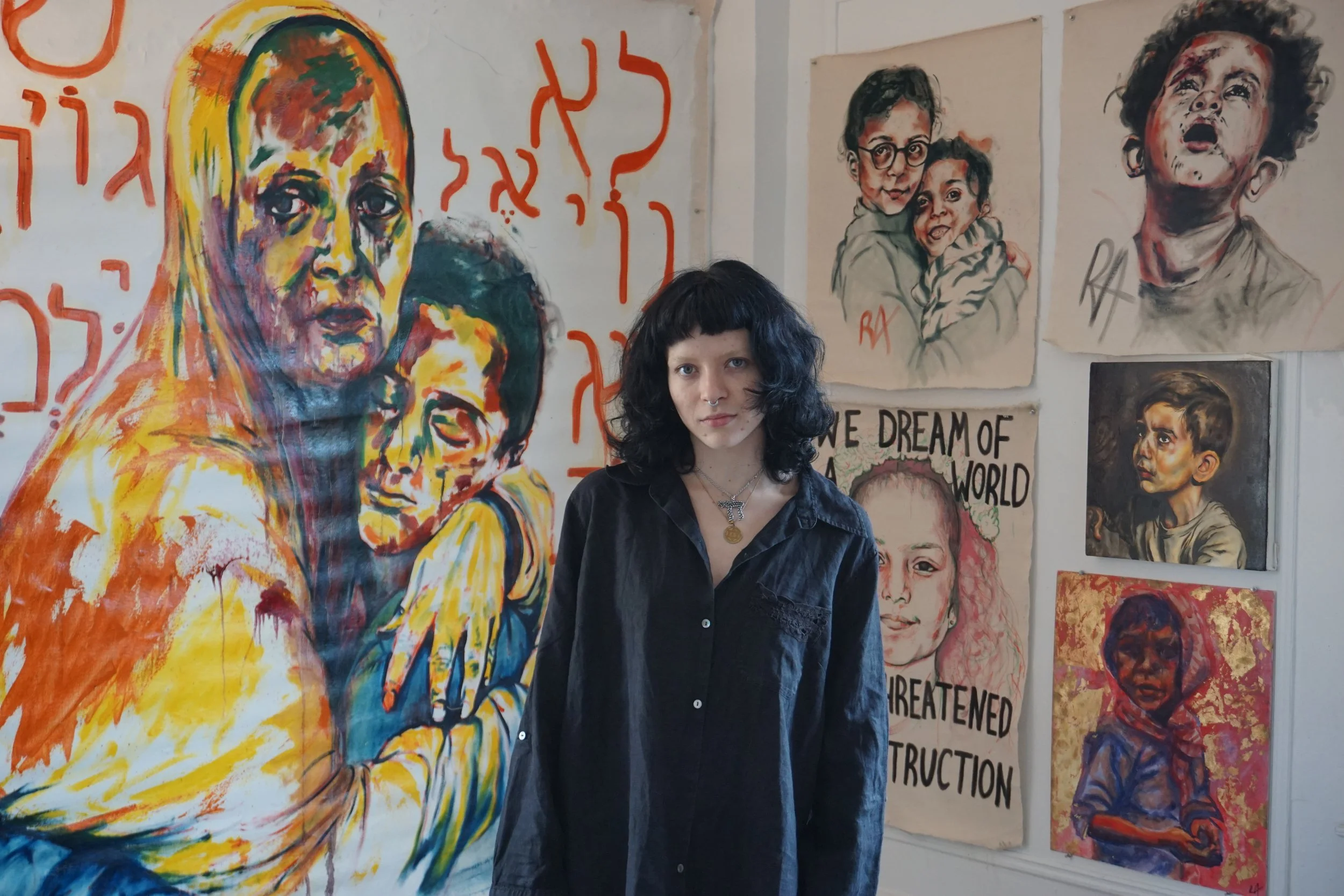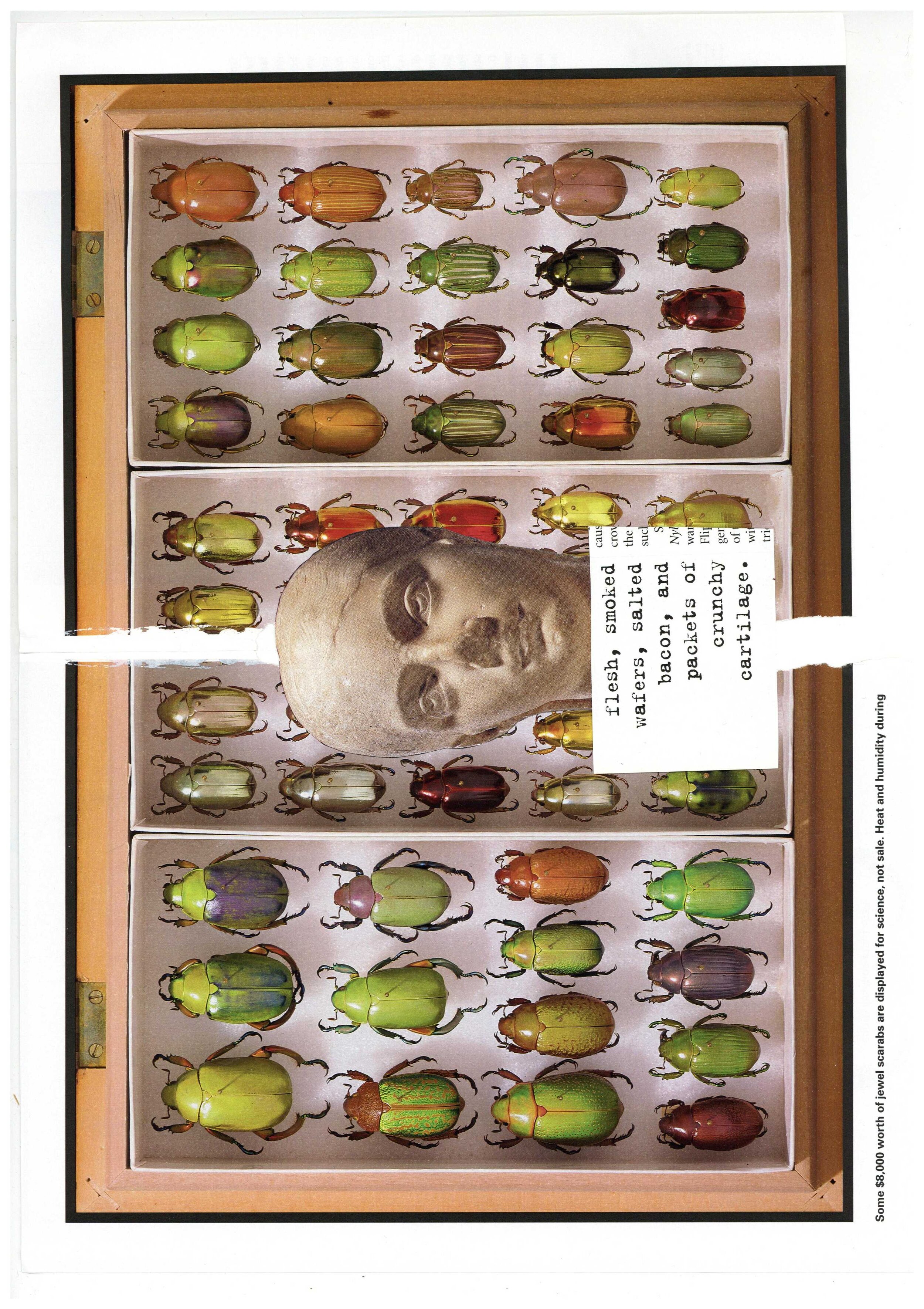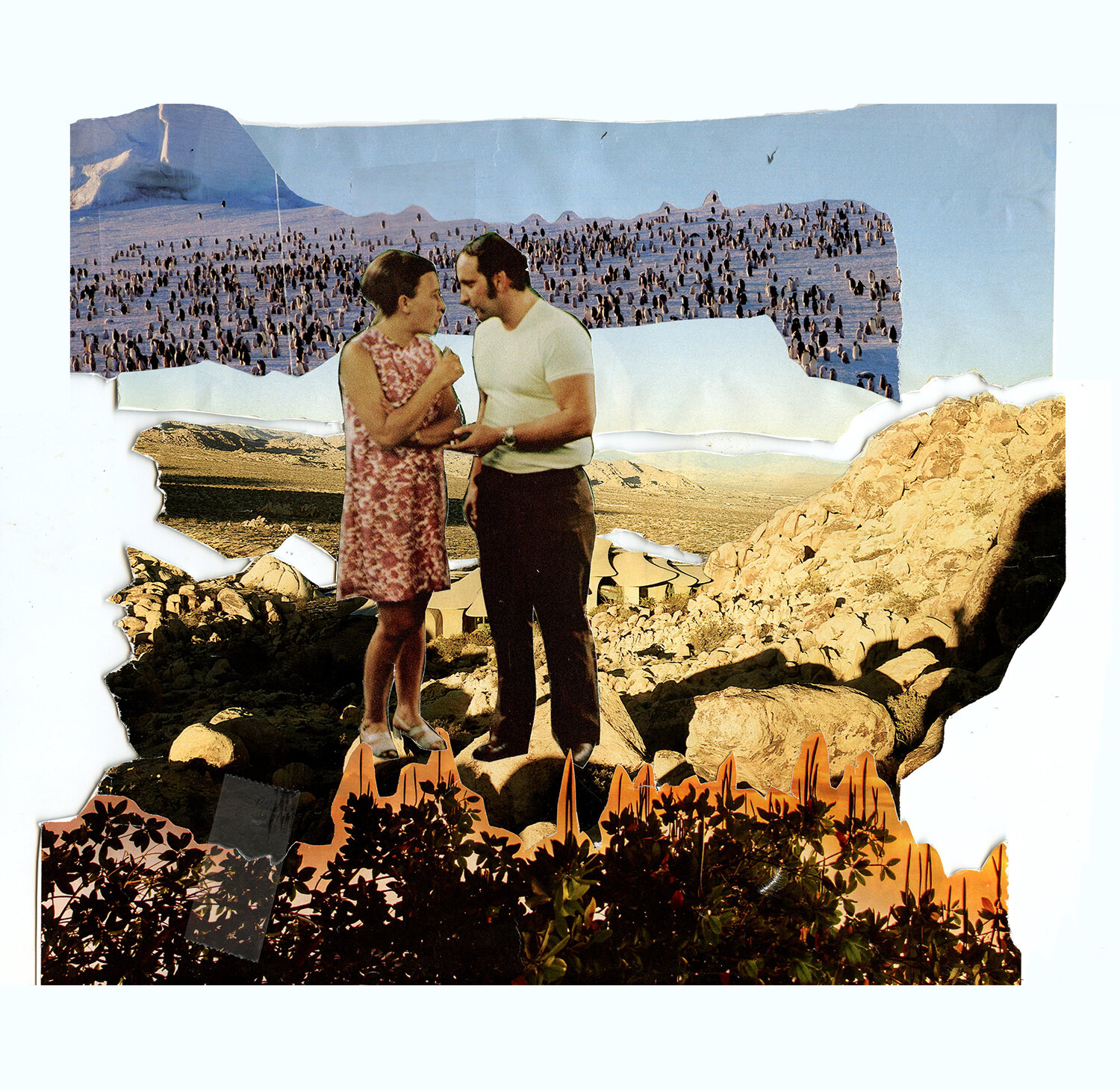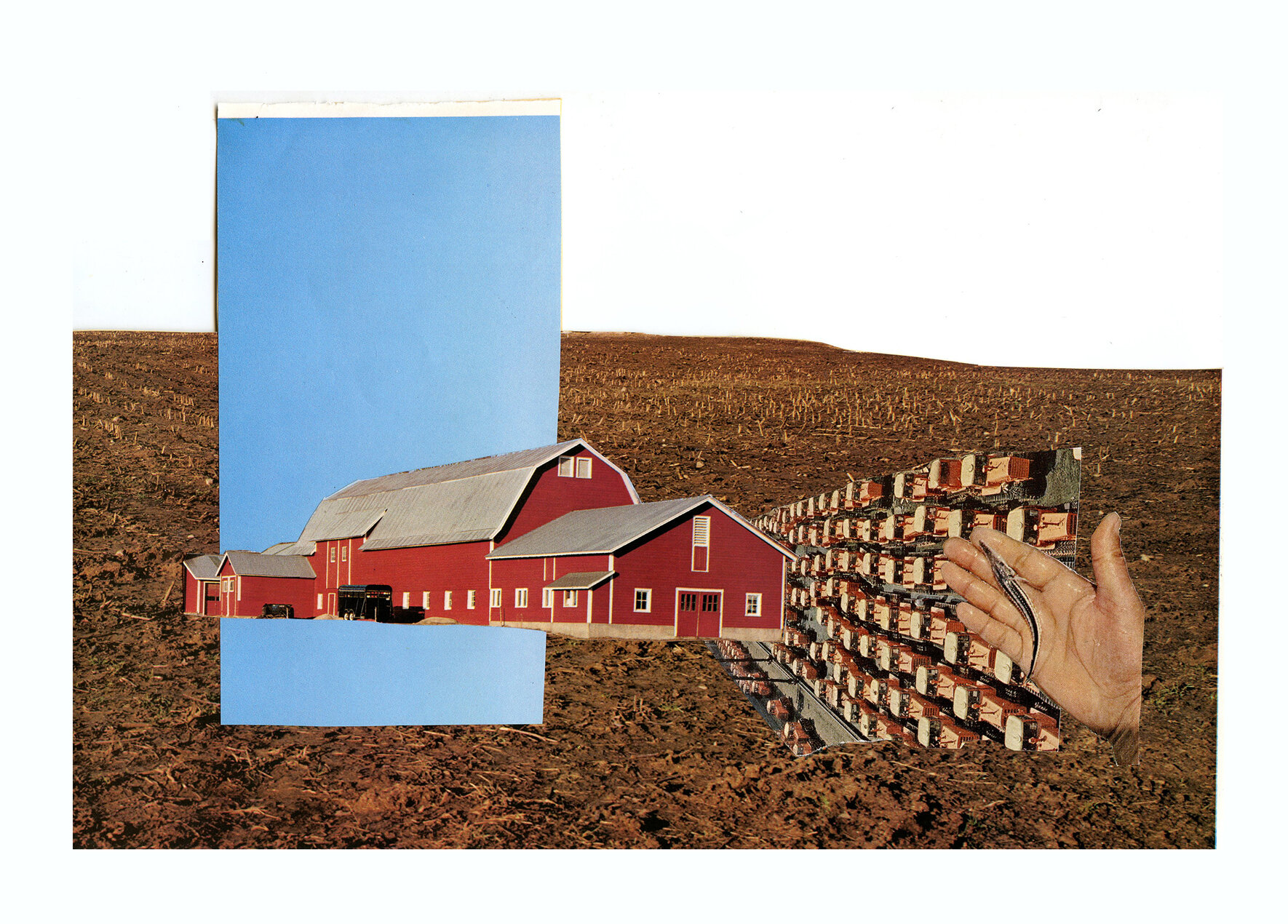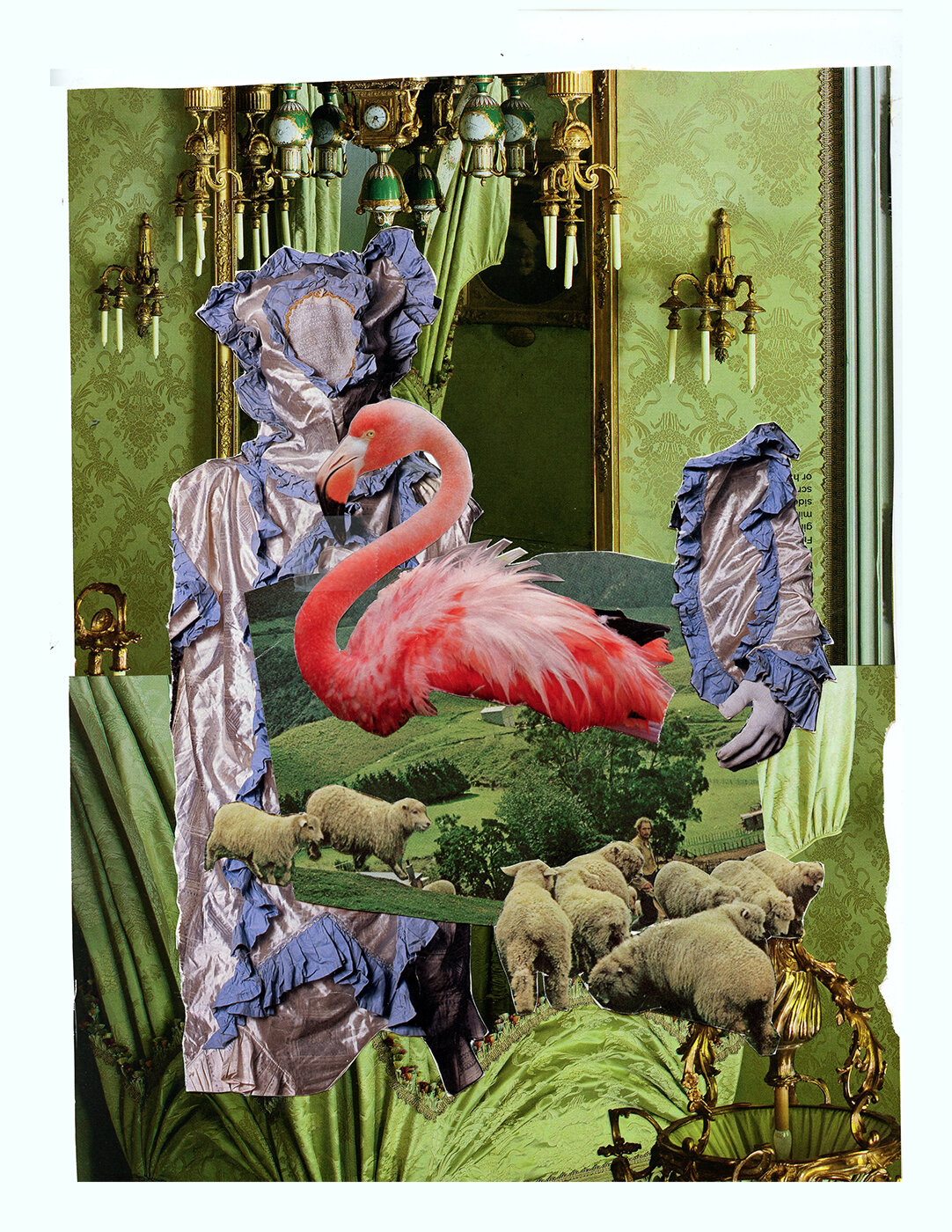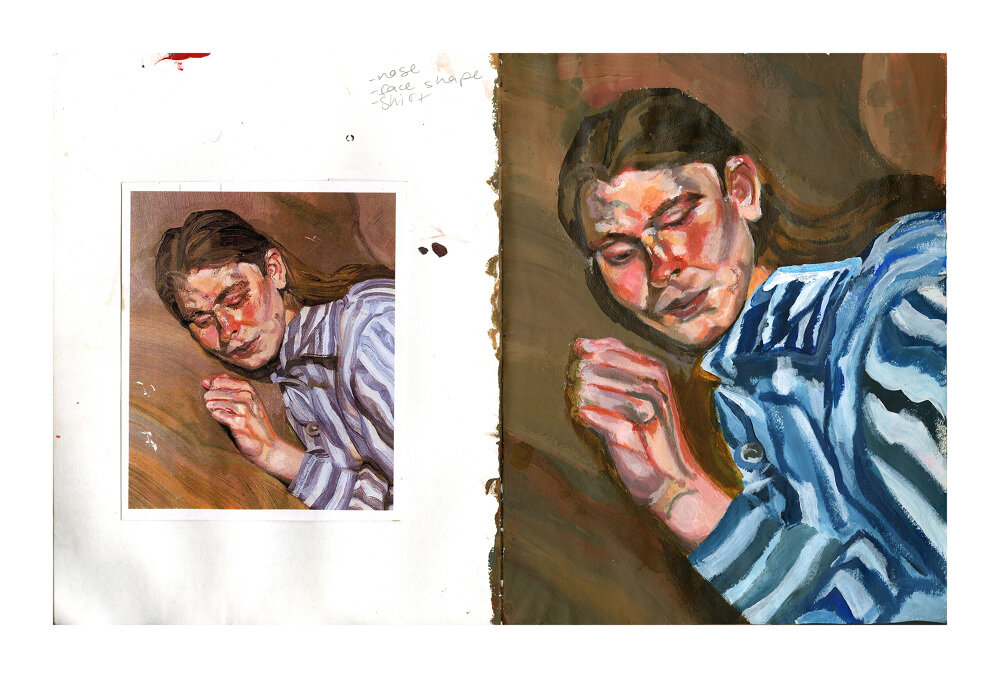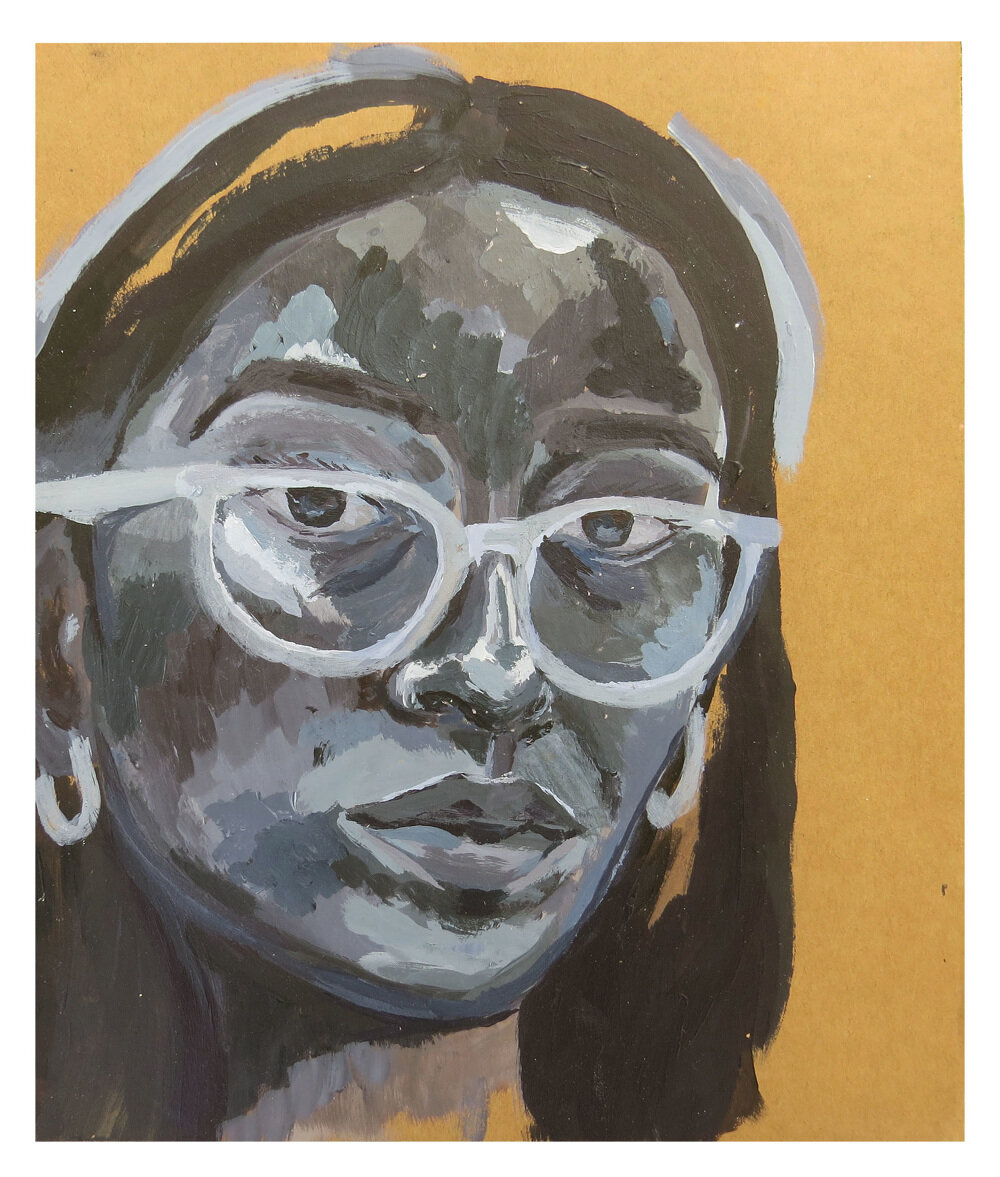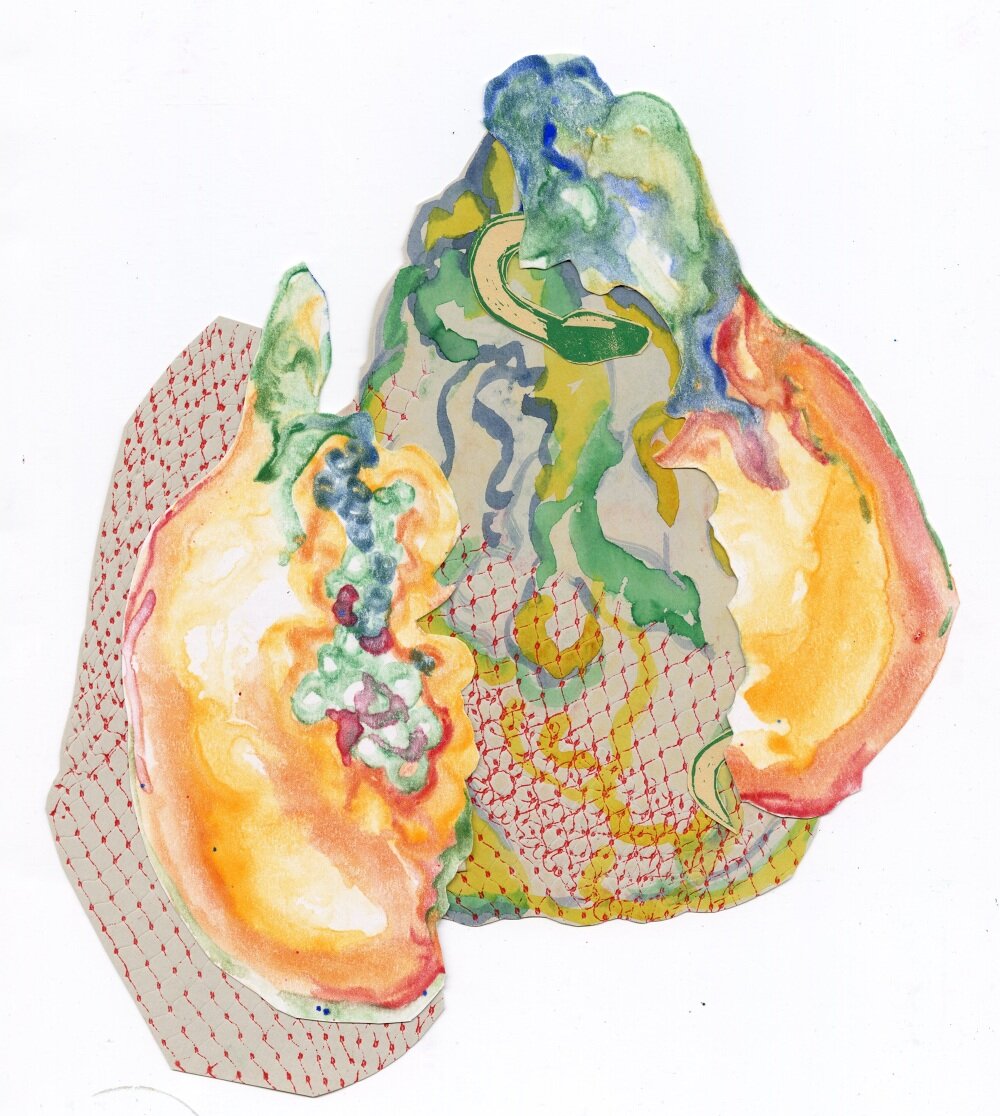Interview by Leni Sperry-Fromm
Photos by Emma Snoddy on FaceTime
Introduce yourself.
I’m Sofia Grosso, I’m Colombian-American but I grew up in South Florida. I think both of these things have a lot to do with my work, which I didn’t realize until recently. I’ve always made art because both of my parents are artists so I grew up around that. My work is mostly about color and light that move me. So in my collages, I look for color relationships, and then they kind of make themself.
What have you been studying at school?
Originally, I was double majoring in Art History and Economics, but now I think I’m gonna double major in Latin American Studies and Economics instead. Just because I wanted to look more specifically at Latino cultural production.
Are you currently in Florida?
Yes, I’ve been here for the fall semester.
I know you work with collage, but also across other mediums. Did you get started in one medium in particular? Or more generally, how did you get started with art, what mediums grabbed you?
I think in a drawing class in middle school––I went to an arts middle school and I took this drawing class and the teacher was like, You’re kinda good at this. That’s weird. You should probably take more of these classes. So, I think that drawing class was maybe my first official introduction. I mean, I always made little crafts and things but I never thought of it as “art.” But my teacher said, this can have a meaning, you can do this on purpose. Then, in high school––I also went to an arts high school––I focused on visual art and got more into printmaking, which was kind of an extension of drawing. I liked the process of it, how tactile it is. I started collaging my prints, which made me think, what if I just made regular collages? And currently, I’m exploring more collage and collaging my own photographs as opposed to going and finding things in magazines and other things.
I’m interested to hear more about color. What are the differences for you, if there are, between how color comes up in your different mediums?
Color is my favorite part of the work. I don’t really use color theory specifically, but in my paintings, on principle, I never like to use black. It just kills every other color. Just finding two colors that work well together, they’re greater than the sum of its parts. That sounds so cheesy, but I think it’s really evocative of something. Color can be so evocative. I think that’s what draws me to it and why it comes up in my work so often. It all feels like part of one idea for me because it’s always the same kind of feeling that I’m trying to evoke. Maybe a feeling of wonder. I think what’s fun about it for me is the process, because in painting and collaging you have to search for the colors so differently.
Painting is really dependent on you and the colors you can put together, and it’s much more delicate because if you mix something wrong it can throw off the whole balance. It can turn south very quickly which is part of the challenge, part of what makes it fun. But then in collage, it’s more of a search, like a scavenger hunt, where you’re always looking for the missing piece that will complement whatever you found. I feel like they’re both really fun, it just depends. Maybe in collage, it just makes itself more because there’s whatever other color is waiting for you in the material you’re working with. Whereas with paint you have to be more intentional and set out to have a specific relationship and balance.
It’s really interesting that a lot of your work deals with tensions, or, as you put it in your artist statement, “fundamentally unfixed objects.” When you go into creating a collage or another piece, are you specifically thinking about these things or does that more come forward naturally?
I do think about it because I want there to be an element of fantasy or comedy to it. I want there to be some whimsy. Maybe because my dad’s a cartoonist, so he’s always thinking about visual metaphors or paradoxes and I think that makes for really powerful work in general. I like to see that, so that’s why I put it into my work, to see how you can change the way you see things, re-contextualize things in your day-to-day life after seeing them used differently in collage.
That’s awesome. You mentioned that both of your parents are artists, so I wonder how that has affected your work, in a similar way potentially?
My dad is a cartoonist and he’s always working, so that’s part of my reality. I think he just revealed to me the ease with which you can create things. It doesn’t have to be hard. A lot of times when I was first starting, it felt hard to even come up with an idea of what to paint or focus on. But I think the more I paid attention to him, the more I realized that it’s quite simple. You just have to follow what your gut tells you. You know what you like, and you just have to listen to that. So he’s always helped me with that.
My mom studied art history and was an artist for a good while, but in my life, she’s always been other things like an art teacher, and more recently she’s worked with kids. There’s always been a creative aspect in that too. She always finds ways to get the need to make things out into the world. So that’s always been interesting to see, and also I think the way that kids take to art is really beautiful. I’m grateful to have always had a connection to that through her, even past the point of when I was little or when my siblings were little. I could still be reminded of that joy.
You also mentioned you went to an arts high school; how was that for you and how did it influence you as an artist? Have you been able to take art classes at Columbia or find other creatives?
It was so cool! I didn’t realize it was an experience that not everyone shared until I got to Columbia. I think what was coolest about it is that the environment supported you on whatever journey that you were taking because everyone was looking for what kind of work it was they wanted to make, or what message they were trying to send through the work. So you always had a sounding board, and you always had someone to, just like help you mix a color. The community aspect of it was definitely my favorite part. Everyone just wanted to help each other do their best. Honestly, I didn’t think that would be the case at Columbia but people here have been very helpful as well. With creatives, I’m not exactly sure how to explain it, but it’s just different. Maybe because it’s understood that everyone likes art and that at the end of the day everyone wants to see an exciting image, people understand each other more. Yeah, ultimately I just felt safe to grow in that space and that’s all I could ask for.
I think Ratrock has definitely helped me find that community at Columbia. I was so excited when I went to my first meeting. The other art hoes! I had finally found them! [laughs] I haven’t been able to take any art classes because they’re just really long blocks, but hopefully I’ll get to do that in the future. I walked into the printmaking studio once though, I think it’s the one that the M.A. students use. I was so excited, I walked in even though I wasn’t really supposed to and it was just so beautiful. All the people were so welcoming and showed me around, even though they were kinda like why are you here? [laughs] and I was like I have no idea and while I was on my way back out and apologizing they turned around saying No, no it’s fine! Come look at our work! So, I was really excited to see that the community is still there, and hopefully to be a bigger part of it.
As you're talking, it makes me think about how the pandemic has recontextualized all of these things, like location, maybe in a more literal way. Has the pandemic affected your work in any particular way?
Because I’m faced with the same three rooms every day, I’ve gotten more into photography, which has changed my perspective on my house in a sense. And more generally, I realized how important creating art is in terms of self-care. Like, I just feel the need to make it now. I had never physically needed to make art like that, but recently it’s helped me think through things, I guess. I was never the kind of artist who, like, when they were really sad and going through a breakup or something, they made a painting about it. That was never really me; I did it because it was fun. But with all the intense and horrible things happening in the world, art is a good medium to express those feelings.
I also think this experience has made me want to explore more than I did before. I was getting pretty comfortable with collage, but now I want to see what I can do beyond that. I’ve been painting again for a little while and exploring other mediums, especially closer together than I had before.
You mentioned earlier that you’ve recently been thinking more about how being Colombian-American affects your work. I’m curious to hear where that’s come up for you and how you see it in your work. I saw on your website that you use “symbols of Latin American otherness” which sounded so interesting, could you expand on that a bit?
I often go for stereotypes, like there was this one painting I made of a plate of beans and a serape table cover. It speaks to the concept of Latinos as a monolith in the country, and how I observed how people at my school and in my life would refer to Latinos, and feeling othered because I was part of that.
My print work and my painting are more geared towards being Latina and that part of my identity, speaking to that experience as opposed to speaking to interesting composition. I find it kind of hard to do that through my collage work, but in combining my own photography with collage, I’m finding ways to do that. There’s this new project that I’m gonna do where I’ll take pictures of people who work at—there are a lot of these small Latino supermarkets in my area—so I’m taking pictures of them and of the supermarket and collaging that. I think that will be really interesting.
I understand that a sense of place and location belongs in your work. So, how has that experience of moving to New York and then back to Florida affected your work?
I’m from a part of Florida that is very suburban, so I always thought it was interesting that I could be anywhere in the world and it would look the same. Going to New York, where every place has such a specific identity, that contrast was kind of difficult to get used to. I think for my work, being back home has made me very nostalgic for New York, even though I’ve only spent nine months there. And being in New York also made me very nostalgic about home, so that was interesting too. Like, I got back into my old collage materials and I was reconsidering certain compositions because they reminded me of home.
Being home raises these questions of roots, hometown, and what it means to be “from somewhere.” I’m curious if you can speak to that at all? What are the things you’ve noticed or found that ground it in a sense of place?
Yeah, that’s definitely something I’ve been considering. I’m interested in talking about placeless places. The place I’m from has this; it’s very placeless in that it could be anywhere. But being back in Florida, I’ve realized how it does have certain distinctive things that ultimately, I do identify with. I feel like a lot of people from Florida, they just don’t like being from Florida, and that’s their personality trait [laughs]. I feel like I relate to that a lot, but I also have a different appreciation for it being back here. There’s a kind of beauty here that I used to take for granted.
Maybe it’s just getting more acquainted with my specific area, like my specific block. I’ve been going on walks a lot and there will be dogs that live in specific parts of the walk and now I know where they live, and they only live here. Things like that, the little parts of it that didn’t seem important before but now it’s the little parts that build up the whole. They’re important too.
It’s interesting this sense of place, because like you were saying earlier, New York has that real sense of place and I think that makes moving here such a distinct experience. I’m from a rural area, and I remember moving to New York, being struck by just how much metal and concrete was around. And it reminds me of this tension between the interior/exterior, natural/mechanized that you use in your work. Could you talk a little bit about that balance?
Yeah, I thought it was very interesting because it felt more natural to be in New York than to be in Florida. Maybe because of who I expected to be in Florida. It really is a lot of retired people here [laughs], and I don’t particularly identify with that demographic. So, it was hard to feel like part of this community, whereas in New York the whole point is that everyone is different. So that was interesting, that being different made me feel like part of it.
I remember in New York the first thing I noticed is that the sky felt smaller because the buildings were so much taller, there was just so little space left. I guess in Florida, I always feel like I’m looking out into nature, but I can’t really interact with it most of the time, because it’s really hot or it’s a manicured lawn so you’re not really supposed to be on it. It’s made to look at rather than be part of. Whereas in New York, I found that nothing is off-limits so that line is gone. You can sit anywhere and have a picnic on any patch of grass you find. It’s interesting you bring up metal and concrete because I felt like it was all one big interior space.
It seems like you started photographing pretty recently. How did you get into that and how has that been for you?
I just began this year. At my high school, you couldn’t really delve into other media, because our classes really only let you explore what it was that you signed up for, and photography and visual arts were separate. So I never got to do photography then, even though I wanted to try it. I got a camera for my birthday this year and I’ve been experimenting with it a lot. I’m looking for a lot of the same things that I usually look for, and try to create in my paintings and in my collages, in terms of color and light. I’ve had a lot of fun with portraiture, with photography, and with drawings as well. Drawing is cool because you have so much control over the light and the specifics, and for me, it’s very much about lines, I like to cross-sect the whole thing. It’s more tactile in that sense. But, photography gives me a lot of the same satisfaction, because it’s about finding that moment, and that composition that you want to keep. It’s so much fun because you can capture the moment so quickly.
It’s really interesting to me, you’ve brought up this idea of the tactile nature of art or the mechanics of it. How do you see that coming up in your work or in your process?
It’s such a big part of the process. It’s so much fun. It’s interesting how it kind of is a performance, but for yourself. I thought a lot about performance art, especially compared to visual art because the disciplines were very segregated in my high school. Sometimes it feels like they really can’t come together, even though they do in something like set design. It just seems like they’re fundamentally not the same, or you can’t do both. But, I think you always do both because the whole point of making art is making art, which is the process of putting it together. I love watching people draw. I think that, in itself, is a very interesting performance. So yeah, I like that you can capture all that movement into that one frame.
Photographing is so interesting in that way because the action itself is almost like freezing motion.
Yeah. That’s very true. I think about it more as being about the motion of the light. Freezing the light in that particular moment, because it’s always moving, is part of what makes it so powerful for me. And, I think movement is a really big part of my collages too because whenever I collage, I put all the pieces together but then I’m all across the floor, shifting things and layering them until I decide that it’s right. It is about that dance between the pieces and how they want to fit together. So that has a very physical, tactile, element to it.
That’s so cool. So you just started working with photography; what else are you looking to work with in the future? Are there other mediums, themes, or anything else?
I want to do a mural. I’ve really been contemplating that for a while. I think a mural is very much about location because it becomes part of a place. Potentially more multimedia collage as well, not just photo collage but maybe mixing in printmaking, or even painting and drawing. I find that kind of difficult because I don’t think I’ve found the balance yet. I’m still searching for that and I want to keep working with that.
I’m curious to hear what you think about consuming and making art in this current moment. It’s something we talked about a bit earlier, but I’d love to know more about what art has meant for you during this extraordinary time.
It definitely goes back to what I was saying earlier about looking more closely at my surroundings. I find that every time I go on a walk or any time I turn my head I feel like that composition I see could be a painting. So, I’ve been able to find the inspiration in that, instead of in things that I normally would in a museum. I think it’s also become more about my friends’ work, not looking for the inspiration or the interesting bits on the outside, like at an exhibition. Instead finding it within a community, and drawing inspiration from that. Maybe getting back to the things I like the most, which is seeing other people create. And getting excited because they’re excited.
That’s such a beautiful thing to see. Lastly, I just wanted to check in to see if there was anything you want to plug or let people know about any work you have coming up?
Wow. It’s crazy I can do that. [laughs] I’m gonna have a show with PostCrypt in January, I think. So that’s coming up, and it’ll be an online gallery so we’re hoping to make it really interactive, people should check that out! And my work is always on my website.

